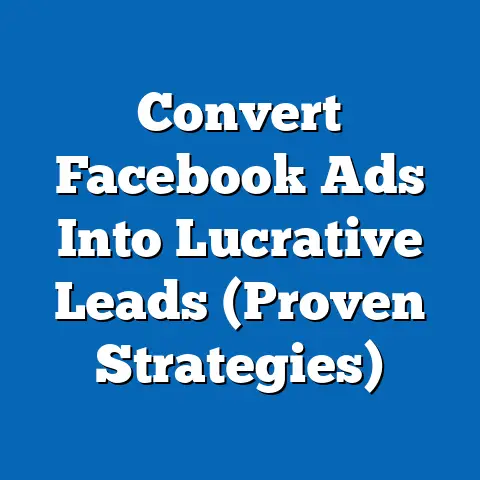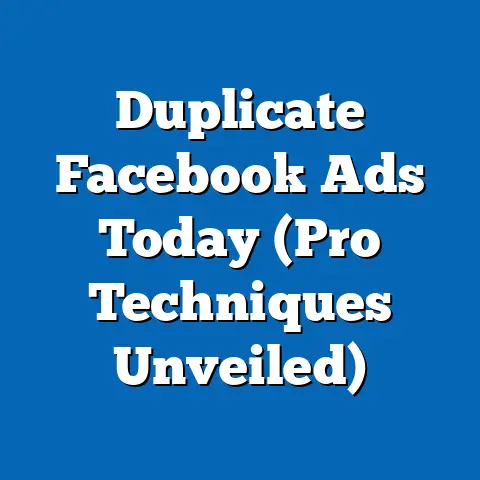Boost Sales with BigCommerce Facebook Ads (Proven Strategy)
As the leaves change and the air gets crisper, one thing is certain: the holiday season is right around the corner! I’ve seen firsthand how businesses can either thrive or simply survive this crucial time of year. It’s a period of increased consumer spending, a whirlwind of gift-giving, and a make-or-break opportunity for many e-commerce stores. Standing out in a crowded market requires more than just great products; it demands a smart, targeted advertising strategy. That’s where the power of Facebook Ads, seamlessly integrated with a robust platform like BigCommerce, comes into play.
In this article, I’m going to walk you through proven strategies to boost your sales through effective Facebook advertising during this critical seasonal period. BigCommerce provides the perfect foundation, offering a seamless integration with Facebook Ads, allowing you to maximize your sales potential and reach new customers with precision. Get ready to transform your seasonal marketing and make this your most successful year yet!
Understanding Your Audience
One of the biggest mistakes I see businesses make is launching ad campaigns without truly understanding their target audience. It’s like throwing darts in the dark – you might hit something, but it’s unlikely to be the bullseye. To craft a successful Facebook Ads strategy, especially during a season with unique consumer behaviors, you need to dive deep into who your customers are.
Demographics and Psychographics with Facebook Insights
Facebook Insights is your secret weapon. This powerful tool provides a wealth of data about your audience, including:
- Demographics: Age, gender, location, education, and relationship status.
- Interests: Hobbies, pages they like, topics they engage with.
- Behaviors: Purchase history, device usage, online activity.
I remember working with a small boutique clothing store that was struggling to reach the right customers. By analyzing their Facebook Insights, we discovered that their ideal customer wasn’t just “women aged 25-45,” but specifically “eco-conscious millennials interested in sustainable fashion and ethical brands.” This insight completely changed their ad messaging and targeting, resulting in a significant increase in sales.
Creating Customer Personas
Once you’ve gathered data from Facebook Insights, it’s time to create detailed customer personas. These fictional representations of your ideal customers will guide your ad creation and targeting efforts.
Consider these elements when building your personas:
- Name and Photo: Give your persona a name and find a stock photo that represents them. This helps make the persona feel more real.
- Background: Include information about their age, occupation, income, and education.
- Goals and Challenges: What are they trying to achieve, and what obstacles are they facing?
- Values and Beliefs: What’s important to them? What do they care about?
- Shopping Habits: Where do they shop? What influences their purchasing decisions?
For example, let’s say you’re selling holiday-themed home decor. Your persona could be “Sarah, the Festive Mom,” a 35-year-old working mother who values creating a warm and inviting home for her family during the holidays. Her challenges include finding unique and affordable decorations while juggling work and family responsibilities.
Seasonal Trends and Customer Behavior
During the holiday season, customer behavior shifts dramatically. People are actively searching for gifts, decorations, and festive items. They’re also more susceptible to emotional appeals and nostalgic messaging.
Here are some seasonal trends to keep in mind:
- Increased Spending: Consumers are generally more willing to spend money during the holidays.
- Gift-Giving Focus: Many purchases are made as gifts for others.
- Time Sensitivity: The holidays create a sense of urgency and deadlines.
- Emotional Connection: People are seeking experiences and products that evoke feelings of joy, nostalgia, and connection.
I’ve learned that tailoring your ads to these seasonal trends can significantly boost engagement and conversions. For example, using phrases like “perfect gift for mom” or “create a magical holiday atmosphere” can resonate strongly with seasonal shoppers.
Gathering Data to Refine Targeting
Don’t rely solely on Facebook Insights. Supplement your data with information from:
- Previous Campaigns: Analyze past campaign performance to identify what worked and what didn’t.
- Website Analytics: Track visitor behavior on your website to understand what products and content are most popular.
- Customer Surveys: Ask your customers directly about their preferences and shopping habits.
- External Sources: Research industry trends and consumer behavior reports to gain a broader perspective.
By combining these data sources, you can create a comprehensive understanding of your audience and refine your targeting for maximum impact.
Takeaway: Knowing your audience is the foundation of any successful Facebook Ads campaign. Use Facebook Insights, create detailed customer personas, and stay informed about seasonal trends to target your ads with precision.
Crafting Compelling Ad Content
Now that you know who you’re talking to, it’s time to craft ad content that grabs their attention and compels them to take action. A compelling Facebook ad is more than just a pretty picture; it’s a carefully crafted message that resonates with your target audience and drives them to your desired outcome.
Elements of a Successful Facebook Ad
A successful Facebook ad typically includes the following elements:
- Attention-Grabbing Headline: A short, punchy headline that immediately captures attention.
- High-Quality Visuals: Eye-catching images or videos that showcase your product or service.
- Clear and Concise Copy: A brief description that highlights the benefits of your offer.
- Strong Call-to-Action (CTA): A clear instruction that tells people what you want them to do (e.g., “Shop Now,” “Learn More,” “Sign Up”).
I’ve found that testing different combinations of these elements is key to finding what works best for your audience. A/B testing allows you to experiment with headlines, visuals, and CTAs to optimize your ad performance.
Seasonal Themes and Enhanced Engagement
During the holiday season, incorporating seasonal themes into your ad content can significantly enhance engagement.
Consider these ideas:
- Holiday-Related Visuals: Use festive images and videos that evoke the spirit of the season.
- Seasonal Messaging: Incorporate holiday-related keywords and phrases into your ad copy (e.g., “Christmas gifts,” “holiday decorations,” “New Year’s Eve party”).
- Limited-Time Offers: Create a sense of urgency with limited-time discounts and promotions.
- Festive Branding: Add a touch of holiday cheer to your brand’s logo and visual elements.
I once helped a local bakery create a Facebook ad campaign for their holiday-themed cupcakes. By using mouthwatering photos of their cupcakes decorated with festive sprinkles and incorporating phrases like “perfect for holiday gatherings,” they saw a significant increase in orders.
The Power of Storytelling
People connect with stories. During the holiday season, when emotions are running high, storytelling can be particularly effective.
Consider these storytelling techniques:
- Share Customer Testimonials: Feature real stories from satisfied customers who have used your product or service.
- Create a Narrative: Develop a short story that highlights the benefits of your offer.
- Focus on Emotions: Evoke feelings of joy, nostalgia, and connection in your ad copy and visuals.
For example, a jewelry store could create a Facebook ad featuring a heartwarming story about a couple celebrating their anniversary with a special gift. This emotional appeal can resonate strongly with viewers and drive them to consider purchasing jewelry for their loved ones.
Effective Ad Copy and Visual Examples
Let’s look at some examples of effective ad copy and visuals that resonate well with seasonal shoppers:
-
Example 1: Clothing Store
- Headline: “Get Holiday Ready with Our Festive Collection!”
- Visual: A photo of models wearing stylish holiday outfits in a cozy setting.
- Copy: “Shop our latest collection of holiday apparel and accessories. Perfect for parties, family gatherings, and festive celebrations. Limited-time discounts available!”
- CTA: “Shop Now”
-
Example 2: Home Decor Store
-
Headline: “Create a Magical Holiday Atmosphere at Home!”
- Visual: A video showcasing beautifully decorated homes with festive lights and decorations.
- Copy: “Transform your home into a winter wonderland with our unique holiday decorations. From twinkling lights to cozy throws, we have everything you need to create a magical atmosphere.”
- CTA: “Explore Our Collection”
-
Example 3: Food Delivery Service
-
Headline: “Stress-Free Holiday Meals Delivered to Your Door!”
- Visual: A photo of a delicious holiday feast being enjoyed by a happy family.
- Copy: “Skip the cooking and enjoy more time with your loved ones this holiday season. Order your holiday meal from us and get it delivered right to your door. Limited-time offer: 10% off your first order!”
- CTA: “Order Now”
Example 1: Clothing Store
- Headline: “Get Holiday Ready with Our Festive Collection!”
- Visual: A photo of models wearing stylish holiday outfits in a cozy setting.
- Copy: “Shop our latest collection of holiday apparel and accessories. Perfect for parties, family gatherings, and festive celebrations. Limited-time discounts available!”
- CTA: “Shop Now”
-
Example 2: Home Decor Store
-
Headline: “Create a Magical Holiday Atmosphere at Home!”
- Visual: A video showcasing beautifully decorated homes with festive lights and decorations.
- Copy: “Transform your home into a winter wonderland with our unique holiday decorations. From twinkling lights to cozy throws, we have everything you need to create a magical atmosphere.”
- CTA: “Explore Our Collection”
-
Example 3: Food Delivery Service
-
Headline: “Stress-Free Holiday Meals Delivered to Your Door!”
- Visual: A photo of a delicious holiday feast being enjoyed by a happy family.
- Copy: “Skip the cooking and enjoy more time with your loved ones this holiday season. Order your holiday meal from us and get it delivered right to your door. Limited-time offer: 10% off your first order!”
- CTA: “Order Now”
Example 2: Home Decor Store
Headline: “Create a Magical Holiday Atmosphere at Home!”
Example 3: Food Delivery Service
Headline: “Stress-Free Holiday Meals Delivered to Your Door!”
Takeaway: Crafting compelling ad content is essential for capturing attention and driving conversions. Use attention-grabbing headlines, high-quality visuals, clear and concise copy, and strong calls-to-action. Incorporate seasonal themes, storytelling techniques, and real-world examples to resonate with your target audience.
Setting Up Your BigCommerce Facebook Ads
Now that you have a solid understanding of your audience and how to craft compelling ad content, it’s time to dive into the technical aspects of setting up your BigCommerce Facebook Ads. The seamless integration between BigCommerce and Facebook makes this process relatively straightforward, but it’s important to follow the steps carefully to ensure optimal performance.
Step-by-Step Guide to Setting Up Facebook Ads Through BigCommerce
-
Connect Your BigCommerce Store to Facebook:
- In your BigCommerce control panel, go to “Marketing” > “Facebook Ads.”
- Click “Connect to Facebook” and follow the prompts to link your Facebook account.
- You’ll need to grant BigCommerce permission to access your Facebook Business Manager.
-
Set Up Your Facebook Pixel:
-
The Facebook Pixel is a small piece of code that tracks visitor behavior on your website. It’s essential for measuring the effectiveness of your ads and optimizing campaigns.
- BigCommerce will automatically install the Facebook Pixel on your website when you connect your store to Facebook.
- Verify that the pixel is working correctly by using the Facebook Pixel Helper Chrome extension.
-
Sync Your Product Catalog:
-
To create dynamic product ads, you’ll need to sync your BigCommerce product catalog with Facebook.
- In your BigCommerce control panel, go to “Marketing” > “Facebook Ads” and click “Sync Product Catalog.”
- Follow the prompts to create a Facebook catalog and upload your product data.
-
Create Your Ad Campaign:
-
In your Facebook Ads Manager, click “Create” to start a new campaign.
- Choose your campaign objective (e.g., “Conversions,” “Traffic,” “Catalog Sales”).
- Define your target audience based on demographics, interests, and behaviors.
- Set your budget and schedule.
- Choose your ad format (e.g., “Single Image,” “Carousel,” “Collection”).
- Create your ad content, including headlines, visuals, and copy.
- Add a clear call-to-action.
- Review your ad and click “Publish.”
Connect Your BigCommerce Store to Facebook:
- In your BigCommerce control panel, go to “Marketing” > “Facebook Ads.”
- Click “Connect to Facebook” and follow the prompts to link your Facebook account.
- You’ll need to grant BigCommerce permission to access your Facebook Business Manager.
-
Set Up Your Facebook Pixel:
-
The Facebook Pixel is a small piece of code that tracks visitor behavior on your website. It’s essential for measuring the effectiveness of your ads and optimizing campaigns.
- BigCommerce will automatically install the Facebook Pixel on your website when you connect your store to Facebook.
- Verify that the pixel is working correctly by using the Facebook Pixel Helper Chrome extension.
-
Sync Your Product Catalog:
-
To create dynamic product ads, you’ll need to sync your BigCommerce product catalog with Facebook.
- In your BigCommerce control panel, go to “Marketing” > “Facebook Ads” and click “Sync Product Catalog.”
- Follow the prompts to create a Facebook catalog and upload your product data.
-
Create Your Ad Campaign:
-
In your Facebook Ads Manager, click “Create” to start a new campaign.
- Choose your campaign objective (e.g., “Conversions,” “Traffic,” “Catalog Sales”).
- Define your target audience based on demographics, interests, and behaviors.
- Set your budget and schedule.
- Choose your ad format (e.g., “Single Image,” “Carousel,” “Collection”).
- Create your ad content, including headlines, visuals, and copy.
- Add a clear call-to-action.
- Review your ad and click “Publish.”
Set Up Your Facebook Pixel:
The Facebook Pixel is a small piece of code that tracks visitor behavior on your website. It’s essential for measuring the effectiveness of your ads and optimizing campaigns.
Sync Your Product Catalog:
To create dynamic product ads, you’ll need to sync your BigCommerce product catalog with Facebook.
Create Your Ad Campaign:
In your Facebook Ads Manager, click “Create” to start a new campaign.
Different Types of Ads and Their Seasonal Benefits
Facebook offers a variety of ad formats, each with its own strengths and benefits. During the holiday season, certain ad types can be particularly effective:
- Carousel Ads: Showcase multiple products in a single ad, allowing customers to browse a selection of items. This is great for highlighting gift ideas or different variations of a product.
- Collection Ads: Create a visually immersive experience that encourages customers to browse and discover products. This is ideal for showcasing a curated collection of holiday-themed items.
- Video Ads: Capture attention with engaging video content that tells a story or demonstrates the benefits of your product. This is great for creating emotional connections and building brand awareness.
I’ve found that using a mix of ad formats can help you reach a wider audience and achieve different marketing objectives. For example, you could use video ads to build brand awareness and carousel ads to drive product sales.
Syncing Product Catalogs from BigCommerce to Facebook Shops
Facebook Shops allows you to create a seamless shopping experience directly on Facebook and Instagram. By syncing your BigCommerce product catalog with Facebook Shops, you can enable customers to browse and purchase your products without ever leaving the social media platform.
To set up Facebook Shops:
- Go to your Facebook Business Manager and click “Commerce Manager.”
- Click “Add Shop” and follow the prompts to set up your shop.
- Connect your BigCommerce product catalog to your shop.
- Customize your shop’s appearance and add products.
- Publish your shop and start selling!
The Importance of Pixel Tracking
As I mentioned earlier, the Facebook Pixel is essential for tracking the effectiveness of your ads and optimizing campaigns. It allows you to:
- Track Conversions: See which ads are driving sales and other valuable actions.
- Retarget Website Visitors: Show ads to people who have previously visited your website.
- Create Lookalike Audiences: Find new customers who are similar to your existing customers.
- Optimize Ad Delivery: Improve the performance of your ads by showing them to the people who are most likely to take action.
Takeaway: Setting up your BigCommerce Facebook Ads involves connecting your store to Facebook, setting up the Facebook Pixel, syncing your product catalog, and creating your ad campaigns. Utilize different ad types and leverage Facebook Shops to create a seamless shopping experience. Don’t forget the importance of pixel tracking for measuring ad effectiveness and optimizing campaigns.
Budgeting and Bidding Strategies
Determining an appropriate budget and choosing the right bidding strategy are crucial for maximizing your ROI on Facebook Ads, especially during the seasonal peak when competition is high.
Determining an Appropriate Budget
There’s no one-size-fits-all answer to the question of how much to spend on Facebook Ads. The appropriate budget will depend on factors such as:
- Your Business Goals: What are you trying to achieve with your ads? (e.g., increase sales, generate leads, build brand awareness)
- Your Target Audience: How large is your target audience?
- Your Industry: What’s the average cost per click (CPC) and cost per acquisition (CPA) in your industry?
- Your Ad Quality: Are your ads engaging and relevant to your target audience?
As a general guideline, I recommend starting with a small budget and gradually increasing it as you see positive results. You can also use Facebook’s budget recommendations tool to get an estimate of how much you should spend based on your campaign objectives and target audience.
Automatic vs. Manual Bidding
Facebook offers two main bidding strategies:
- Automatic Bidding: Facebook automatically sets your bids to get the most results for your budget. This is a good option for beginners or for campaigns where you don’t have a lot of data to work with.
- Manual Bidding: You manually set your bids for each ad set. This gives you more control over your spending and allows you to optimize your bids based on performance data.
I typically recommend starting with automatic bidding and then switching to manual bidding once you have enough data to make informed decisions.
Allocating Budgets for Various Ad Types and Campaigns
To maximize your ROI during the seasonal peak, it’s important to allocate your budget strategically across various ad types and campaigns.
Consider these factors:
- Prioritize High-Performing Campaigns: Allocate more budget to campaigns that are already delivering positive results.
- Test New Ad Types: Experiment with different ad types to see which ones resonate best with your audience.
- Allocate Budget for Retargeting: Retargeting ads tend to be highly effective because they target people who have already shown an interest in your products or services.
Takeaway: Determine an appropriate budget based on your business goals, target audience, industry, and ad quality. Choose the right bidding strategy (automatic vs. manual) and allocate your budget strategically across various ad types and campaigns.
Analyzing and Optimizing Campaign Performance
The final step in your BigCommerce Facebook Ads strategy is to analyze and optimize your campaign performance. This is an ongoing process that involves tracking key metrics, identifying areas for improvement, and making data-driven decisions to enhance ad effectiveness.
Using Facebook Ads Manager to Track Campaign Performance
Facebook Ads Manager is your central hub for tracking and analyzing your campaign performance. It provides a wealth of data about your ads, including:
- Impressions: The number of times your ad was shown.
- Reach: The number of unique people who saw your ad.
- Click-Through Rate (CTR): The percentage of people who clicked on your ad.
- Conversion Rate: The percentage of people who took a desired action (e.g., made a purchase, signed up for a newsletter).
- Cost Per Click (CPC): The average cost you paid for each click on your ad.
- Cost Per Acquisition (CPA): The average cost you paid for each conversion.
- Return on Ad Spend (ROAS): The amount of revenue you generated for every dollar you spent on ads.
I recommend regularly monitoring these metrics to identify trends and patterns in your campaign performance.
A/B Testing to Optimize Ad Performance
A/B testing involves creating two or more versions of an ad and then comparing their performance to see which one performs better. This is a great way to optimize your ad content, targeting, and bidding strategies.
Consider these A/B testing ideas:
- Test Different Headlines: Try different headlines to see which ones grab attention and drive clicks.
- Test Different Visuals: Experiment with different images and videos to see which ones resonate best with your audience.
- Test Different Ad Copy: Try different ad copy to see which one communicates the benefits of your offer most effectively.
- Test Different Audiences: Target different audiences to see which ones are most responsive to your ads.
- Test Different Bidding Strategies: Experiment with different bidding strategies to see which one delivers the best results for your budget.
Making Data-Driven Decisions
The key to optimizing your Facebook Ads campaign is to make data-driven decisions. Don’t rely on gut feelings or hunches; instead, use the data from Facebook Ads Manager to inform your decisions.
For example, if you notice that one of your ads has a low CTR, you might try changing the headline or visual to make it more attention-grabbing. If you see that one of your audiences has a high CPA, you might try narrowing your targeting to reach a more qualified audience.
Takeaway: Analyze and optimize your campaign performance by using Facebook Ads Manager to track key metrics, conducting A/B testing to optimize ad elements, and making data-driven decisions to enhance ad effectiveness.
Conclusion
Boosting sales with BigCommerce Facebook Ads during the seasonal peak requires a strategic and data-driven approach. I’ve outlined the key steps to success: understanding your audience, crafting compelling ad content, setting up your ads through BigCommerce, budgeting and bidding effectively, and continuously analyzing and optimizing campaign performance.
By utilizing BigCommerce and Facebook Ads together, you can connect with your customers on a deeper level, drive sales, and enhance your brand visibility. Don’t let this seasonal opportunity pass you by. Take action now by implementing these strategies and watching your business thrive!
The holiday season is a time of connection, celebration, and growth. Embrace the opportunity to connect with your customers, showcase your products, and grow your business through effective advertising.
Now, I’d love to hear from you! What are your biggest challenges when it comes to Facebook Ads? Share your experiences or questions in the comments section below to foster engagement and community interaction!






